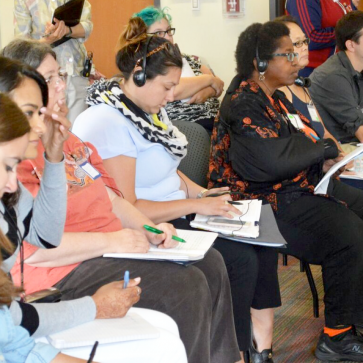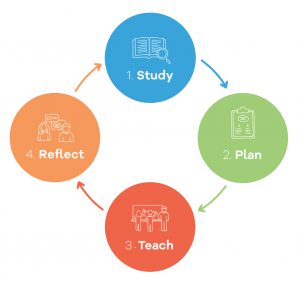Lesson Study works best with rich subject content. This course offers step-by-step support to conduct a Lesson Study cycle on fractions, by providing fractions resources and research to examine.

Professional development that is going to make a difference to students in the classroom must be teacher driven and student focused. Lesson Study is both of these things.
— Lynn Liptak, Paterson Public School No. 2
Lesson Study Overview

In Lesson Study, a team of educators collaborates to:
- STUDY an aspect of student learning they want to improve
- PLAN or refine a research lesson, anticipating student responses
- TEACH the research lesson, carefully observing and collecting data on student thinking during the lesson and sharing it during a post-lesson discussion
- REFLECT on the data collected during the research lesson, draw out implications for teaching and learning, and identify what was learned from the cycle that should be shared with others
Some groups choose to revise the lesson and teach it in another classroom, once again collecting data that enable them to deepen their understanding of the topic and its teaching and learning.
Before Your Team Begins
Lesson Study asks that teachers work collaboratively. Start by agreeing on norms and routines for your work together, using the tools suggested below.
As you get ready for your first meeting:
- Look over the sample agendas for your team’s first meeting in the resource tile below. You will find two sample agendas for a first meeting: one for groups familiar with lesson study, and another for groups that are new to lesson study. (Please feel free to modify or use your own preferred agenda template.)
- Set or revisit group norms or agreements (see resource tile) to help you ensure a good learning environment for all team members, and support efficient, inclusive meetings.
- Choose roles, such as convener, facilitator, note-taker, and timekeeper. Many groups like to rotate these roles for each meeting.
If your group is new to Lesson Study, you will notice that the sample agenda for your first meeting incorporates time to learn about the Lesson Study process and view and discuss the video “How Many Seats?” together. As a result, you may need to allocate a longer meeting or use part of your second meeting.
As You Participate in Each Meeting
We suggest that you use an agenda to guide each meeting; the sample agendas above can be used as a guide.
When your team is solving mathematical tasks, we recommend that you provide time for team members to solve the task independently before the group shares solution strategies. We think both students and adults benefit from time to solve a mathematical task independently before hearing others’ ideas.
To help you keep track of your thinking along the way, and to help us learn from it, team members should individually complete brief Meeting Reflection Forms (see below) at the end of each Lesson Study meeting. These meeting reflections may also be useful for sharing ideas within your group. After team members have had a chance to fill out individual reflection forms near the end of each meeting, they may want to share some ideas with the team. Recording these in the team notes and reading them as you begin your next meeting may help your group quickly dive back into the work.
Accessing the Teaching-Learning Plan
Your team will use the Teaching-Learning Plan to capture what you learn as you study the curriculum and content. Take a quick look at the Teaching-Learning Plan now, so you will be familiar with it for future reference. Decide where your team will store the Teaching-Learning Plan. Many teams save it to a shared Google folder where team members can collaborate online.
Click the link below to open the document in Google Drive. You will be prompted to make a copy of the document for your own use. If you prefer, you can also download the template as a Word document to collaborate in a more traditional fashion.



